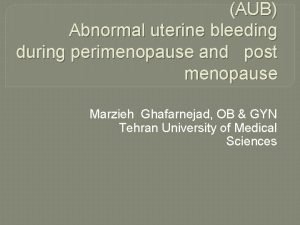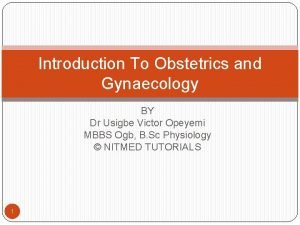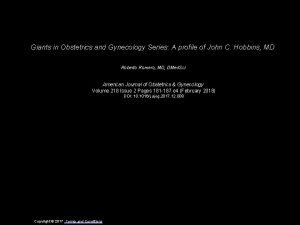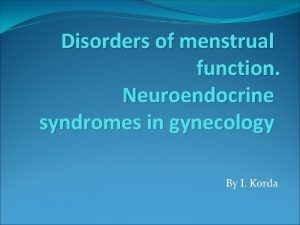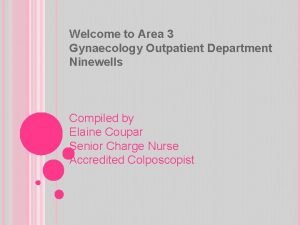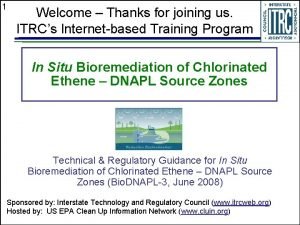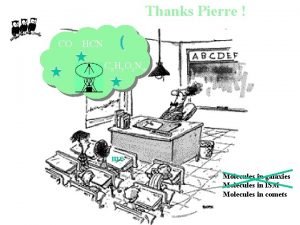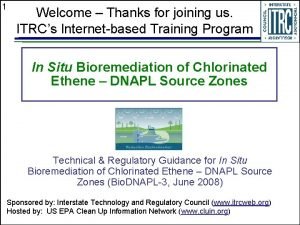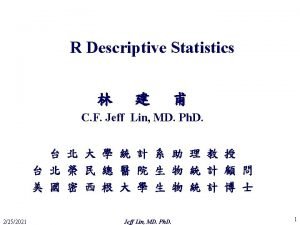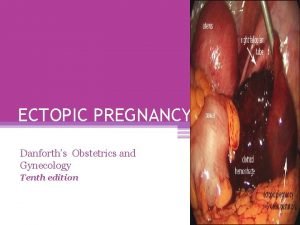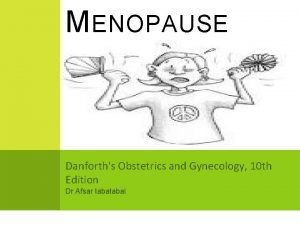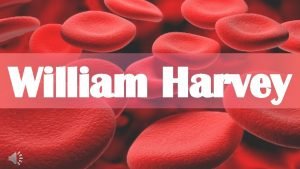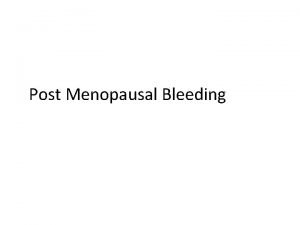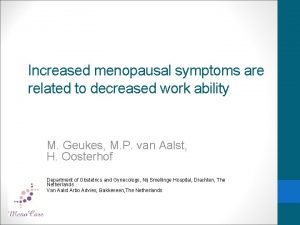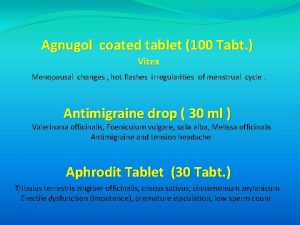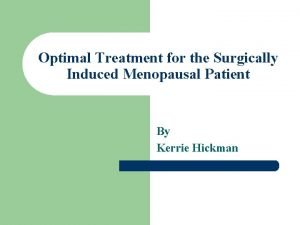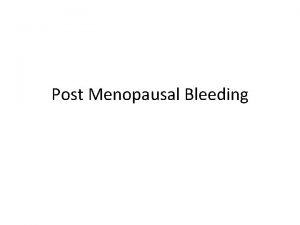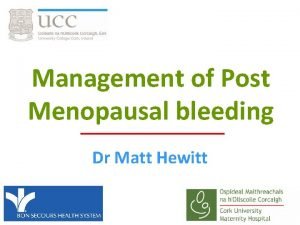MENOPAUSAL TRANSITION William Gynecology 21 th edition Thanks




























































- Slides: 60

MENOPAUSAL TRANSITION William’ Gynecology 21 th edition

Thanks for listening Q and A n n n What’s the definition of menopausal transition and -5~-1 of reproductive stage for a women? What’ are risk factors for hot flush? How to D. D. abnormal uterine bleeding? How to prevent osteoporotic fracture? … 10/7/2020 Dr. Bi-Hua Cheng 2

10/7/2020 Dr. Bi-Hua Cheng 3

Symptoms Associated with Menopausal Transition Changes in menstrual patterns Shorter cycles are typical (by 2– 7 days) Longer cycles are possible Irregular bleeding (heavier, lighter, with spotting) Vasomotor symptoms Hot flushes Night sweats Sleep disturbances Psychological and metal disturbances Worsening premenstrual syndrome Depression Irritability Mood swings Loss of concentration Poor memory 10/7/2020 Dr. Bi-Hua Cheng 4

Sexual dysfunction Vaginal dryness Decreased libido Painful intercourse Somatic symptoms Headache Dizziness Palpitations Breast pain and enlargement Joint aches and back pain Other symptoms Urinary incontinence Dry, itchy skin Weight gain 10/7/2020 Dr. Bi-Hua Cheng 5

PHYSIOLOGICAL CHANGES 1. Hypothalamus-Pituitary-Ovarian Axis Changes 2. Ovarian Changes 3. Adrenal Steroid Level Changes 4. Sex Hormone-Binding Globulin Level Changes 5. Endometrial Changes 10/7/2020 Dr. Bi-Hua Cheng 6

premenopausal ovaries have greater volume and contain follicles, which are seen as multiple, small, anechoic smooth-walled cysts postmenopausal ovaries have smaller volume and are characteristically devoid of follicular structures 10/7/2020 Dr. Bi-Hua Cheng 7

2. Ovarian Changes n Ovarian senescence is a process from birth,primordial follicles are continuously being activated, mature partially, and then regress. 400 ovulatory 700, 000 oocytes 10/7/2020 40 s A more rapid depletion of ovarian follicles Dr. Bi-Hua Cheng 8

3. Adrenal Steroid Level Changes 6. 2 micromoles 1. 6 micromoles n n n DHEAS concentrations peaked at ages 20 to 30 years, and then decreased steadily. , and then decreases to 74 percent at aged 70 to 80 years. Androstenedione peaks at ages 20 to 30 years and then decreases to 62 percent of this peak level in women aged 50 to 60 years. Pregnenolone diminishes by 45 percent from reproductive life to menopause 10/7/2020 Dr. Bi-Hua Cheng 9

n Because the ovary contributes to the production of these hormones during the reproductive years, but after menopause, only the adrenal gland continues this hormone synthesis 10/7/2020 Dr. Bi-Hua Cheng 10

5. Endometrial Changes Microscopic changes in the endometrium directly reflect the level of systemic estrogen and progesterone In a proliferative endometrium, the glands are rounded and closely packed and have tall columnar epithelium with mitosis Secretory endometrium shows tortuous glands lined by cells with cytoplasmic and luminal secretions 10/7/2020 Dr. Bi-Hua Cheng 11

In pregnancy, these changes become more pronounced with a hypersecretory effect demonstrated by cell clearing and cytoplasmic blebs Inactive endometrial tissue shows only scattered, inactive nonproliferating glands in the basalis. With endometrial atrophy, cystic changes can occur 10/7/2020 Dr. Bi-Hua Cheng 12

EVALUATION OF ABNORMAL BLEEDING n n n Sonography Endometrial Biopsy: D & C Hysteroscopy targeted biopsy: q n n q submucous leiomyomas, endometrial polyps, or focal areas of endometrial hyperplasia or endometrial cancer with misoprostol 100 mg orally the night before and the morning of scheduled hysteroscopy, to ease cervical dilation. 10/7/2020 Dr. Bi-Hua Cheng 13

Central Thermoregulation Changes 1. INCIDENCE 2. VASOMOTOR SYMPTOMS 3. PATHOPHYSIOLOGY OF VASOMOTOR SYMPTOMS 4. Estrogens 10/7/2020 Dr. Bi-Hua Cheng 14

Hot Flush- frequently with palpitations, anxiety, irritability, and panic. A. Core body temperature. B. Respiratory exchange ratio. 10/7/2020 C. Skin temperature. D. Sternal skin conductance. Dr. Bi-Hua Cheng 15

Interaction between sex steroid hormones and serotonin in the central nervous system (CNS) response n What’s the effects on thermoregulatory in thermoregulatory zone ? 1. 2. 3. 10/7/2020 Neurotransmitters besides estrogen Norepinephrine Serotonin Dr. Bi-Hua Cheng 16

1. Hypothalamus-Pituitary-Ovarian Axis Changes 10/7/2020 Dr. Bi-Hua Cheng 17

This hypothesis is supported by the fact that women with gonadal dysgenesis (Turner syndrome), do not experience hot flushes n Estrogen stabilizes the CNS thermoregulatory set point and leads to a normal response. 10/7/2020 Dr. Bi-Hua Cheng 18

n During menopausal transition, decreased estrogen levels lead to instability of the set point and an altered response to externalthermal stimuli. 10/7/2020 Dr. Bi-Hua Cheng 19

n Gradually over time, the set point becomes stable again. Alternatively, pharmacologic intervention with exogenous estrogen or selective serotonin reuptake inhibitors (SSRIs) may also stabilize the set point 10/7/2020 Dr. Bi-Hua Cheng 20

Take home message -1 Norepinephrine & Serotonin n Significant fluctuations in estradiol levels lead to a decline in inhibitory presynaptic 2 -adrenergic receptors and an increase in hypothalamic norepinephrine and serotonin release n Norepinephrine and serotonin lower the set-point in thermoregulatory nucleus and allows heat loss mechanisms to be triggered by subtle changes in core body temperature. 10/7/2020 Dr. Bi-Hua Cheng 21

Sleep Dysfunction and Fatigue n n fatigue, irritability, depressive symptoms, cognitive dysfunction, and impairment in daily functioning. 10/7/2020 Dr. Bi-Hua Cheng 22

Insomnia by Severity of Hot Flushes and Menopausal Symptoms 10/7/2020 Dr. Bi-Hua Cheng Ohayon (2006) 23

Fatigue Prevention Instructions 1. 2. 3. 4. 5. 6. 7. 8. Obtain adequate sleep every night Exercise regularly to reduce stress Avoid long work hours and maintain your personal schedule If stress is environmental, take vacations, switch jobs, or approach your company or family to help resolve sources of your stress Limit intake of alcohol, drugs, and nicotine Eat a healthy and well-balanced diet Drink adequate amounts water (8 to 10 glasses) during the early part of the day Consider seeing a specialist in menopausal medicine 10/7/2020 Dr. Bi-Hua Cheng 24

Osteoporosis 1. Osteoporosis sequel 2. Pathophysiology 3. Diagnosis 4. Prevention 5. Treatment 10/7/2020 Dr. Bi-Hua Cheng 25

1. Osteoporosis sequelae n Mortality:the risk of dying following a clinical fracture (especially hip fracture) is twofold higher than for persons without fractures 10/7/2020 Dr. Bi-Hua Cheng 26

2. Pathophysiology n Both aging and menopausal estrogen deficiency lead to a significant increase in osteoclastic activity. 10/7/2020 Dr. Bi-Hua Cheng 27

10/7/2020 Dr. Bi-Hua Cheng 28

n n A. DEXA report describing normal hip density. B. DEXA report describing osteopenia of the hip 10/7/2020 Dr. Bi-Hua Cheng 29

A. DEXA report describing normal vertebral body density. B. DEXA report describing vertebral body osteoporosis. 10/7/2020 Dr. Bi-Hua Cheng 30

For each standard deviation of BMD below a baseline level, the fracture risk approximately doubles 。 (National Osteoporosis Foundation, 2003). 10/7/2020 Dr. Bi-Hua Cheng 31

4. Prevention 10/7/2020 Dr. Bi-Hua Cheng 32

Having trouble with the FRAX tool? 10/7/2020 Dr. Bi-Hua Cheng 33



10/7/2020 Dr. Bi-Hua Cheng 36






10/7/2020 Dr. Bi-Hua Cheng 42

Mean percentage change in Bone mneral density at Lumbar Spine (Panel A), Femoral Neck (B), Trochonter (C), Total Hip (D), Total body (E) and Urinary N-Telopeptides of type I Collagen (F) 10 mg alendronate 10/7/2020 5 mg alendronate Dr. Bi-Hua Cheng Discontinue 43

Height loss Women with nonvertebrae fractures No/100 subject-yr 10/7/2020 Dr. Bi-Hua Cheng 44

Cardiovascular Changes CARDIOVASCULAR DISEASE RISK n n n n n CARDIOVASCULAR DISEASE PREVENTION CVD history Hypertension Smoking DM Abnormal lipid profile Obesity Age 2 x~6 X after menopause 3 x Cholesterol > 265 mg 10/7/2020 n n n Physical activity q -walking central obesity Atherogenic lipid q n n n HDL ( ≥ 55~60 mg) Dietary modification Estrogen treatment Lipid-lowering medication Dr. Bi-Hua Cheng 45

Weight Gain and Fat Distribution 45 -54 y/o of metabolic Since menopausal transition - reduction rate n n Significantly greater increase in weight and hip circumference than 55 -65 y/o Less physical activity Less Work activity HRT may decrease slightly the rate of agerelated increases. n n n Insulin resistance Diabetes mellitus Genetic factors Neuropeptides Adrenergic nervous system activity Loss of muscle mass with aging n 10/7/2020 Dr. Bi-Hua Cheng 46

Central Nervous System) Sleep dysfunction (sleep fragmentation) : Cognitive dysfunction (during menopausal transition) commonly associated with 1. 2. 3. 4. 1. hot flushes, nocturia, urinary frequency, urgency 2. 3. 4. depression, mood changes, poor concentration impaired memory 1. daytime fatigue, 2. mood liability, 3. irritability, and 4. problems with short-term memory 10/7/2020 Dr. Bi-Hua Cheng 47

Psychosocial Changes Well-being in midlife? n n n n Libido Changes Dermatologic changes Dental Changes Breast Changes interpersonal stress, Psychosomatic S, premenstrual symptoms ? attitude to menopause current perceived health status Psychosocial factors ? 10/7/2020 n n n n recurrent depression hormonal fluctuations physical and mental health smoking marital satisfaction sexual desire and activity Women reported loss of libido, dyspareunia, and orgasmic dysfunction, with 86 percent reporting no orgasms after menopause (Tungphaisal, 1991) Dr. Bi-Hua Cheng 48

Urogenital pathology Urinary symptoms Thinning of urethral and bladder mucosa Etiology there are estrogen and progesterone receptors in n pelvic floor muscles n pelvic floor ligaments n vulva n Vagina mucosa n bladder mucosa 10/7/2020 n n urethritis with dysuria, urge incontinence, and urinary frequency Dr. Bi-Hua Cheng 49

Prolapse of vaginal wall 10/7/2020 Dr. Bi-Hua Cheng 50

Dyspareunia and Sexual Dysfunction Without estrogen's trophic influence vagina loses 1. 2. 3. collagen, adipose tissue ability to retain water n n vaginal p. H becomes more alkaline and greater than 4. 5 10/7/2020 Vaginal walls n shrink, rugae flatten a flat-walled, pale-pink appearance. surface is left friable Is prone to bleeding with minimal trauma. Dr. Bi-Hua Cheng 51

Pelvic examination loss of the connective tissue Vaginal examination n n shrinkage of the labia majora labia minora may disappear completely a narrowing of the introitus Vulva: redness, atrophy, or scarring Urethra mucosa prolapse 10/7/2020 n n n a narrow vaginal canal and thin vaginal epithelium loss of rugae a pale, dry vaginal mucosa friable, and submucosal petechial hemorrhages PH larger than 5 Dr. Bi-Hua Cheng 52

Differential Diagnosis of Menopausal Symptoms-1 Vaginal dryness, dyspareunia Hot flushes, vasomotor symptoms 1. 2. 3. 4. Hyperthyroidism Pheochromocytoma Febrile illness Anxiety and psychological symptoms 10/7/2020 1. 2. 3. 4. 5. Dr. Bi-Hua Cheng Bacterial vaginosis Yeast infection Pelvic pathology Poor vaginal lubrication Marital discord 53

Differential Diagnosis of Menopausal Symptoms-2 Abnormal uterine bleeding n n n n Anovulation Endometrial cancer Cervical cancer Endometrial hyperplasia Endometrial polyps Uterine leiomyoma Urogenital atrophy Hormone treatment 10/7/2020 Primary osteoporosis n n n Osteomalacia Primary and secondary hyperparathyroidism Hyperthyroidism or excess thyroid replacement Excess corticoid therapy Increased calcium excretion Dr. Bi-Hua Cheng 54

Take home message -2 DIAGNOSIS The diagnosis of menopausal transition can usually be made with n documentation of age-appropriate symptoms (organized questionnaire) n careful physical examination n FHS, Estrogen, AMH n Gyn ultrasound, Hysteroscopy (D. D. ) n Pap smear 10/7/2020 Dr. Bi-Hua Cheng 55

Vaginal wall's maturation index toward basal cell predominance 10/7/2020 Dr. Bi-Hua Cheng 56

MATURATION INDEX- reproductive-aged women A predominance of superficial or superficial 10/7/2020 And intermediate cells (A and B) Dr. Bi-Hua Cheng 57

intermediate vs parabasal cells A predominance of intermediate cellsluteal phase, pregnancy, newborns, premenarchal girls, and early menopausal transition 10/7/2020 A predominance of parabasal cells menopausal patients with atrophy Dr. Bi-Hua Cheng 58

Analytes Considered Markers of Bone Resorption and Resorption Formation 1. 2. 3. 4. Urinary calcium Tartrate resistant acid phosphatase Bone sialoprotein Cross-links v Pyridinoline v Deoxypyridinoline v N-telopeptide v C-terminal telopeptide of type I collagen 10/7/2020 Bone-specific alkaline phosphatase Osteocalcin Procollagen I extension propeptides 1. 2. 3. u Carboxy terminal (PICP) Pyridinoline Amino terminal (PINP) Dr. Bi-Hua Cheng 59 u

Thanks for listening Q and A n n n What’s the definition of menopausal transition and -5~-1 of reproductive stage for a women? What’ are risk factors for hot flush? How to D. D. abnormal uterine bleeding? How to prevent osteoporotic fracture? … 10/7/2020 Dr. Bi-Hua Cheng 60
 Spotting differential diagnosis
Spotting differential diagnosis Introduction of obstetrics and gynecology
Introduction of obstetrics and gynecology Gynecology
Gynecology Neuroendocrine syndromes in gynecology
Neuroendocrine syndromes in gynecology Gynaecology ninewells
Gynaecology ninewells Orchid gynecology
Orchid gynecology Tromboemboly
Tromboemboly Foetotomy
Foetotomy Using mis 10th edition
Using mis 10th edition Zulily case study
Zulily case study William stallings network security essentials 5th edition
William stallings network security essentials 5th edition Write one word for each space
Write one word for each space Thanks for being here
Thanks for being here Best vote of thanks sample
Best vote of thanks sample Dear ben thanks for your letter
Dear ben thanks for your letter Thanks
Thanks Oh give thanks to the lord for he is good
Oh give thanks to the lord for he is good Olfctory
Olfctory Thanks
Thanks Oh give thanks to the lord for he is good
Oh give thanks to the lord for he is good Thanks for your audience
Thanks for your audience Thanks for listen
Thanks for listen Introduice
Introduice Be joyful always pray continually give thanks
Be joyful always pray continually give thanks Thanks for teamwork
Thanks for teamwork Thanks bri
Thanks bri Thanks paul
Thanks paul Give thanks to the lord our god and king
Give thanks to the lord our god and king Vote of thanks
Vote of thanks Thank you to all the sponsors
Thank you to all the sponsors Alleluia alleluia give thanks to the risen lord lyrics
Alleluia alleluia give thanks to the risen lord lyrics Gartner erp matrix
Gartner erp matrix Thanks to provision
Thanks to provision Thanks for your attention.
Thanks for your attention. Thanks for listening
Thanks for listening Small party assisted rescue
Small party assisted rescue In everything give thanks to the lord
In everything give thanks to the lord Barry gane
Barry gane Welcome thanks for joining us
Welcome thanks for joining us Kwakiutl prayer of thanks
Kwakiutl prayer of thanks Give thanks psalms
Give thanks psalms Welcome thanks for joining us
Welcome thanks for joining us Christian kittl
Christian kittl Goodbye mission control thanks for trying
Goodbye mission control thanks for trying Thanks 7
Thanks 7 Thanks pierre
Thanks pierre Thank you for your kind attention
Thank you for your kind attention Michael w smith his love endures forever
Michael w smith his love endures forever Thanks for the victory
Thanks for the victory Thanks for the reminder.
Thanks for the reminder. 謝千萬聲
謝千萬聲 How to reply thanks
How to reply thanks Ifnca
Ifnca Acknowledgement special thanks to
Acknowledgement special thanks to Thanks for bringing us together
Thanks for bringing us together Thank you a lot for your last letter
Thank you a lot for your last letter From woodlands to plains
From woodlands to plains Welcome thanks for joining us
Welcome thanks for joining us Thanks to god for my redeemer
Thanks to god for my redeemer Thanks 2021
Thanks 2021 Thanks for your attention
Thanks for your attention
